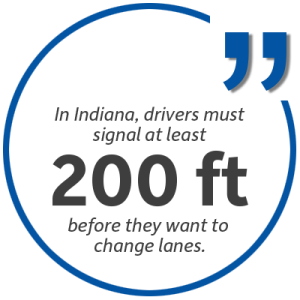According to recent reports, unsafe lane change accidents account for a significant percentage of total traffic collisions, especially on highways where drivers travel in one direction at high speeds.
Whether you changed lanes or your car was hit by other drivers trying to change lanes, understanding the laws surrounding lane changes is important.
In this post, we’ll explore the key considerations for determining fault and seeking compensation.
Basic Laws When Passing Another Vehicle in Indiana

In Indiana, drivers must signal at least 200 feet before they want to change lanes.
Other drivers must also ensure that the lane change can be made safely without interfering with other vehicles in neighboring marked lanes or oncoming traffic.
Failure to comply with these traffic laws and rules creates dangerous circumstances with serious consequences for other drivers. Traffic tickets, personal injury lawsuits, higher insurance rates, and even jail time are possible due to driving recklessly when needing to change lanes.
Indiana’s Comparative Fault Laws

Indiana’s comparative fault system in car accidents means multiple parties can be assigned a percentage of fault based on their actions.
For instance, if both drivers commit unsafe lane changes, liability for such movement may be divided between them accordingly.
Understanding how comparative fault works in driving accidents can help you seek maximum compensation for injuries, property damages, pain, and suffering.
Common Injuries Due to Unsafe Lane Changes
Unsafe lane change crashes can result in a range of injuries, from minor bruises to life-altering conditions.
Injuries common when people make unsafe lane changes and cause rear-end or single-lane side accidents include:
- Whiplash
- Fractures
- Head injuries
- Muscle tears
- Bruises
- Lacerations
- Crush injuries
While these injuries may cause pain that may persist for weeks or months, fatal accidents have a devastating effect on loved ones.
Establishing Fault in Unsafe Lane Change Accidents
When determining fault in a lane change crash, several factors come into play. One crucial aspect is whether the driver changing lanes had enough space to change lanes, and time to do so safely.
The law says every vehicle shall be driven in a manner that avoids dangerous or unsafe lane changes, by first checking blind spots, using turn signals, and taking precautions while driving to avoid endangering other motorists.
Traffic laws state that drivers must also gauge the speed and distance of oncoming vehicles before moving from one lane, choosing to turn left, and considering visibility conditions.
A driver failing to yield or signal properly before changing lanes may be deemed at fault for the traffic accident.
Evidence Collection
Gathering evidence is crucial in establishing fault in an accident. This may include witness statements, reports and notes from the police officer who responded, photographs of the scene, and any available surveillance footage.
Eyewitness testimony from people who see car accidents can point police to the sequence of events leading up to the collision.
All of these types of evidence will paint a clear picture of the unique circumstances of accidents related to unsafe lane changes.
What To Do If You’re In a Lane Change Car Accident
- Check for injuries and move to a safe location: If possible, move vehicles to the side of the road to prevent further accidents and ensure the safety of everyone involved.
- Contact law enforcement: Call the police to report the crash and request assistance. A police report is essential for insurance claims and legal proceedings. The officer can also issue an unsafe lane change ticket that helps prove fault.
- Exchange information: Exchange information with the other drivers involved. Include names, addresses, phone numbers, vehicle license plate numbers, and insurance policy details.
- Document the scene: Take photographs of the scene, including vehicle damage, road conditions, and road signs or signals. Note the direction of each car at the time of the unsafe lane changes. Note contributing factors like a blind spot, dangerous traffic crossing, unclear lane markings, unmarked lanes, or if the at-fault driver was passing.
- Collect witness statements: If there are witnesses, ask what they saw. Did they observe a traffic violation? Was the car drifting out of the designated lane or not following the rules of the road? Their testimony can provide additional evidence to support your case.
- Avoid admitting fault: Don’t admit fault. Stick to factual information when discussing the situation with the other party and law enforcement.
- Notify your insurance company: Report the crash to your insurance company as soon as possible.
- Seek medical attention: Even if you don’t feel injured, seek medical evaluation and keep records of all medical treatment related to the accident.
- Consult with an attorney: Call a personal injury attorney to protect your right to pursue compensation.
Legal Assistance
Navigating a car accident can be overwhelming. An experienced personal injury attorney will help you receive fair compensation for your damages.
They can request the police report, a copy of the unsafe lane change ticket, criminal charges filed, reports of roadway conditions, and a record of who was injured in the crash.
Depending on the circumstances, an experienced unsafe lane change accident attorney can negotiate with insurance companies or file a lawsuit as needed.
Seeking Compensation After an Improper Lane Change Accident
Drivers have a responsibility when changing lanes not to make unsafe lane changes that endanger other cars on the highway. Car accidents caused by unsafe lane movements impact motorists physically, emotionally, and financially.
Compensation may be available for medical expenses, lost wages, property damage, and pain and suffering.
Understanding your rights and options for pursuing compensation is essential for recovering from the aftermath of a car accident.
Understanding Insurance Coverage
Insurance coverage plays a large role in recovering damages when a lane change accident occurs. Liability coverage typically covers damages caused by the at-fault driver, while collision coverage may help repair or replace the insured’s vehicle.
Insurance is complicated whether you’re a victim of an unsafe lane change accident or are being blamed for recklessly moving across two lanes and facing a permanent mark on your driving record.
Involved In an Improper Lane Change Accident? We Can Help.
Dealing with a lawsuit following a crash is exhausting. Instead of trying to do it alone, contact Crossen Law Firm and let us build your case while you focus on your recovery.
Our car accident lawyers have decades of experience helping victims of car accidents recover fair compensation for their injuries.
At Crossen Law Firm, we will do whatever it takes to get the compensation you deserve. Call 317-401-8626 today or reach out online for a free case evaluation.

 317-401-8626
317-401-8626 
.jpg)